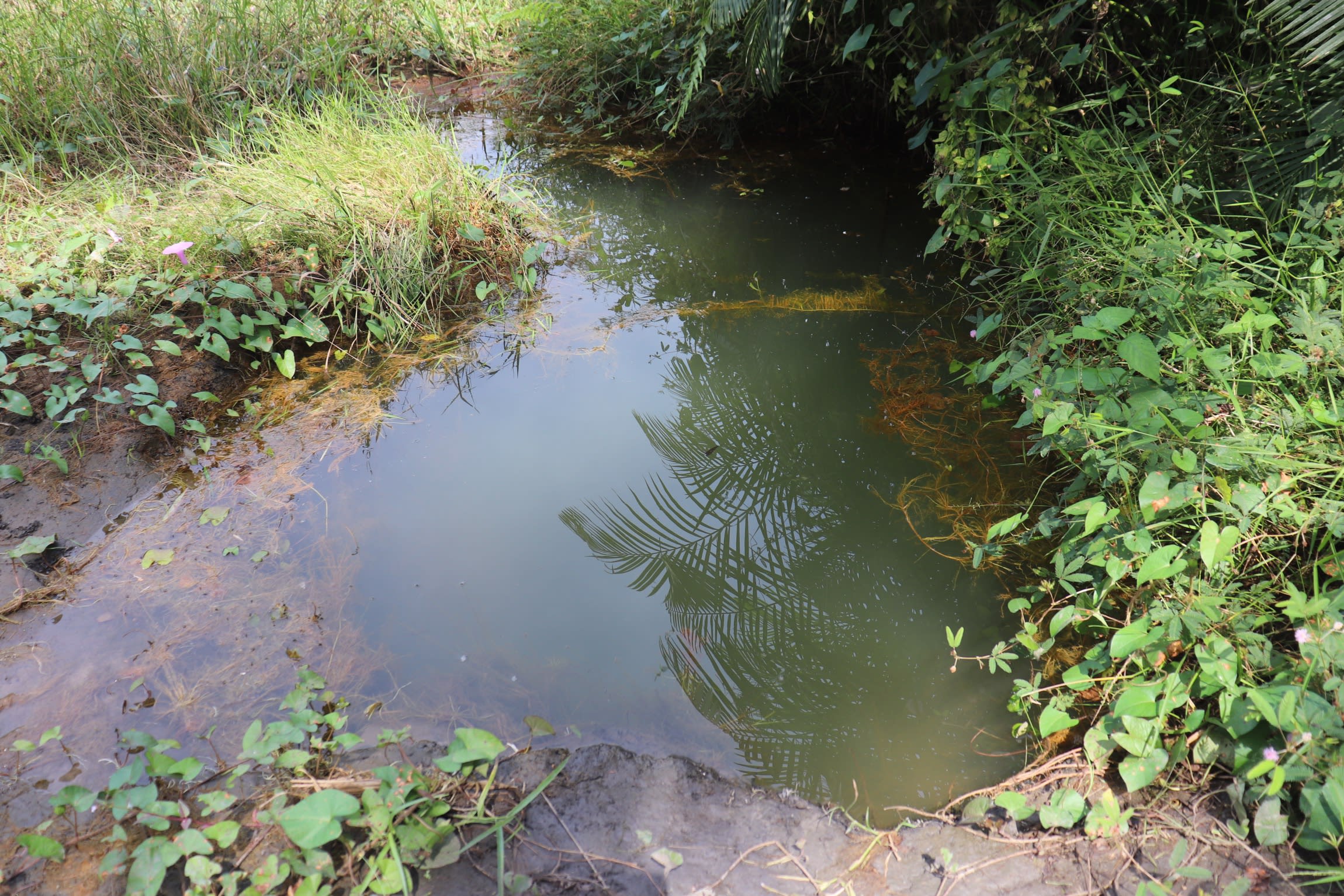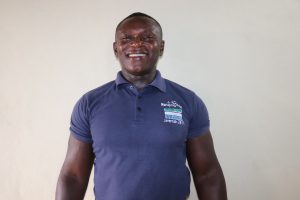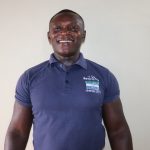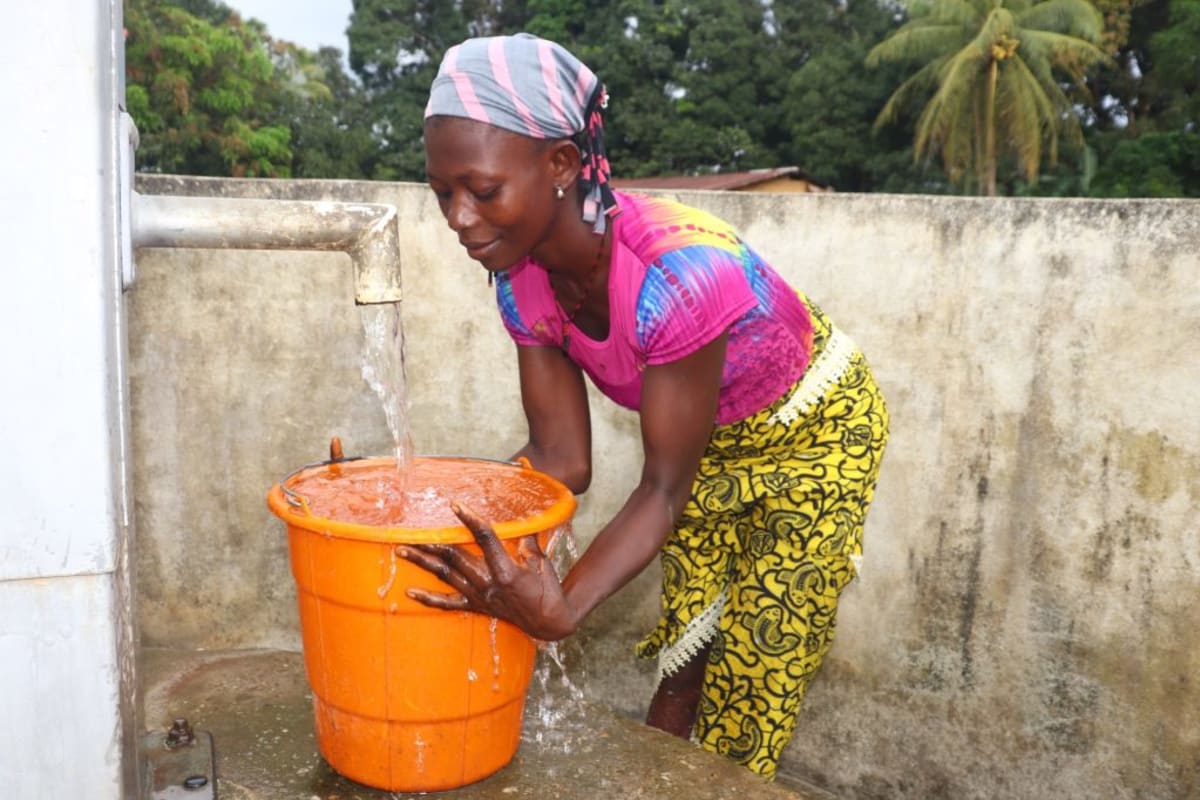February, 2023: Rogbom Community Well Rehabilitation Complete!
We are excited to share that a safe, reliable water point at Rogbom Community in Sierra Leone is now providing clean water to community members! We also conducted hygiene and sanitation training, which focused on healthy practices such as handwashing and using latrines.
"Today is a joyful moment in my life because of the completion of our community water well," said 20-year-old trader Umu Turay. "It was very difficult to see this water well not providing water before, but now it is providing clean and enough water like this."

Umu cups her hands beneath the well's spout.
"The water situation in this village was very challenging," Umu continued. "I personally was negatively affected by the shortage [of] water in this village, especially during the dry season when the water well was [dry]. The swamp water well was the only option that I had for fetching water. It was very difficult for me to fetch the quantity of water that needed from the swamp because of the long distance. My family did not get enough water to use because of the water shortage. My trading was delayed because I could not go out early to trade. This also reduced the amount of money that I received to provide [a] livelihood for my family."

Umu, second from the left, celebrates with other community women.
Umu concluded: "It is good that this water well is now good for me to easily fetch water on time to do all my domestic activities and to do trading. The water from this well is clean, and there is enough water coming from the well. I am very happy because I now have easy access to clean and enough water throughout the year."
"Any time that I was supposed to fetch water from the swamp, I got worried because of the challenges involved," said 14-year-old Isatu K. "It is not easy to make a single trip of water from the swamp. This is the reason there [was never] enough water at my house to use. I would be [too] tired to fetch water after my return to the house from school."

Isatu fills a container with water.
"I am now happy because the water well is properly working for me to easily fetch water to my house without spending more time and using more energy," Isatu said. "I was worried after school about how to fetch water early before my mother [would] return home to prepare food. I am happy because my worries about fetching water from a far distance are now ended because I can fetch water from the water well quickly and do other domestic activities early."

Community members singing and dancing.
We held a dedication ceremony to officially hand over the well to the community members. Several local dignitaries attended the ceremony, including representatives from the Ministry of Water Resources, the Port Loko District Council, and the Ward Council. Each official gave a short speech thanking everyone who contributed to the rehabilitation of the water project and reminding everyone to take good care of it. Then, Umu and Isatu made statements on their community's behalf. The ceremony concluded with celebration, singing, and dancing.
Clean Water Restored
The drill team arrived the day before beginning work. They set up camp and unpacked all their tools and supplies to prepare for drilling the next day. The community provided space for the team to store their belongings and meals for the duration of their stay. The following day, the work began.
First, we raised the tripod, the structure we use to hold and maneuver each drilling tool. Next, we measured the well's original depth. We then socketed the pipes and installed a casing.

Finally, we lined up the drill rods and started to drill! We reached a final depth of 23 meters with water at 16 meters. The hand-drill method allowed the team to install the cylinder far below the aquifer so that the community has excellent water access throughout the year.
With drilling complete, we installed screening and a filter pack to keep out debris when the water is pumped. We then cemented an iron rod to the well lining and fixed it with an iron collar at the top.

Community members brought containers to assist workers with the yield test.
Next, we bailed the well by hand for three days and flushed it, clearing any debris generated by the drilling process. Finally, we tested the yield to ensure the well would provide clean water with minimal effort at the pump.
As the project neared completion, we built a new cement platform, walls, and drainage system around the well to seal it off from surface-level contaminants. The drainage system helps to redirect runoff and spilled water to help avoid standing water at the well, which can be uncomfortable and unhygienic and a breeding ground for disease-carrying mosquitoes.

At last, we installed the pump and conducted a water quality test. The test results showed that this was clean water fit for drinking!

New Knowledge
Before conducting any hygiene training, we called and visited the local water user committee to understand the community’s challenges and lack of sanitation facilities. We shared the findings from our discussions with the committee members to help them make the necessary adjustments before the training began. For example, we identified households without handwashing stations or ones that may need to repair their latrines. With this information, community members worked together to improve hygiene and sanitation at home.
After this preparatory period, we scheduled a time when members from each household using the water point could attend a three-day hygiene and sanitation training. We then dispatched our teams to the agreed-upon location to hold the meeting.

Training topics covered included handwashing and tippy taps, good and bad hygiene habits, disease transmission and prevention, COVID-19, worms and parasites, dental hygiene, proper care of the well's pump, keeping the water clean, the cost recovery system, dish racks and clotheslines, the importance of toilets, keeping latrines clean, balanced diets, the diarrhea doll, and HIV and AIDS.
One topic that sparked a lot of discussion was when facilitators urged pregnant mothers to visit a health center prior to a baby's birth and for the birth itself. One of the participants said there was no need for this because God plans everything and helps everyone, especially during child delivery. Both she and her mother had given birth at home many times without issue.

Another woman in attendance stood up to say that while she was pregnant, she had wanted to visit the local clinic, but her grandmother wouldn't allow her to go. She had friends who died in childbirth, and she didn't want to suffer the same fate. Finally, she defied her grandmother and went to the clinic to give birth to a healthy baby. She told everyone in attendance that going to the clinic was the best way to ensure the health of both mother and baby.
Facilitators reinforced the lesson of visiting a health center when necessary and of having young children vaccinated during the talk about disease transmission. One participant named Adama supported the facilitators' assertion by telling a story about her daughter.

Participants discuss posters showing how diseases transfer from one person to another to put them in order chronologically.
"Adama’s husband was diagnosed with Ebola," explained our field officer Philip. "He was taken to the treatment center. She and her children were quarantined for 21 days. During that process, her third daughter started experiencing a high fever, red eyes, running nose, and a few rashes on her neck, behind her ears, and on her chest. She was afraid of telling anyone, even the health personnel who were observing them for any Ebola symptoms because all the signs her daughter was showing [were] like [those] of the Ebola disease. The child kept suffering until her case was severe. The health workers later noticed the sick girl and took her to the hospital, where she was confirmed measles-positive. The little girl was admitted, but unfortunately for her, the child died two days later because of the delay."
Adama finished the story by telling everyone gathered that either the measles vaccine or a timely visit to the health center would have saved her daughter's life. Since vaccines are free in Sierra Leone for children under five years old, everyone agreed that there would be no reason to delay visiting the health center when they or their child are sick.

Fatmata.
"[The training] is valuable to me because it has helped me to gain more knowledge on the relevance of going to the health center [even] when the sickness is not severe," said 45-year-old farmer Fatmata Kargbo. "I did not know that we lost lives because of our refusal to attend [the] clinic for medical services. I was relying on the past experiences of our parents, who never attended any health care services during their days of childbearing. I will make sure that I turn away from my old way of doing things and continue with the new method. I will also extend this knowledge to those who did not attend the training so we all can practice the right way of living."
Conclusion
This project required a substantial collaboration between our staff, our in-country teams, and the community members themselves. When an issue arises concerning the well, community members are equipped with the necessary skills to rectify the problem and ensure the water point works appropriately. However, if the issue is beyond their capabilities, they can contact their local field officers to assist them.
Also, we will continue to offer them unmatchable support as a part of our monitoring and maintenance program. We walk with each community, problem-solving together when they face challenges with functionality, seasonality, or water quality. Together, all these components help us strive for enduring access to reliable, clean, and safe water for this community.
With your contribution, one more piece has been added to a large puzzle of water projects. In our target areas, we’re working toward complete coverage of reliable, maintained water sources within a 30-minute round trip for each community, household, school, and health center. With this in mind, search through our upcoming projects to see which community you can help next!
Thank you for making all of this possible!





 Borehole Well and Hand Pump
Borehole Well and Hand Pump


































